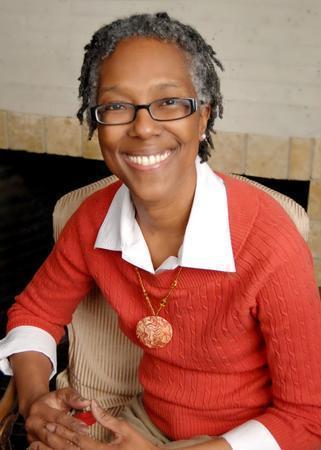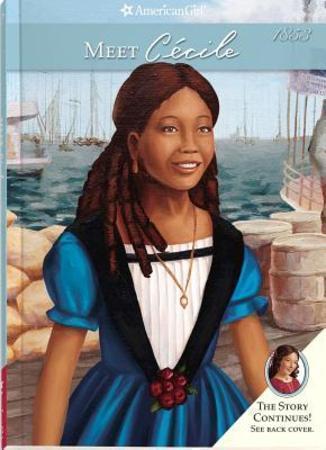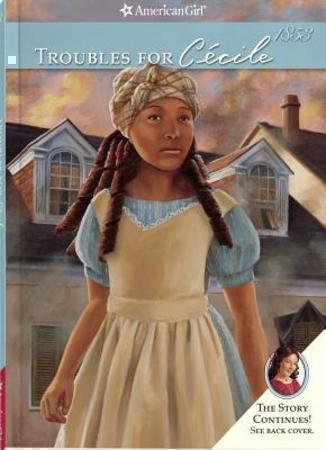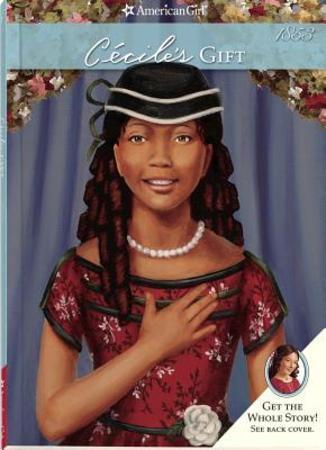
Denise Lewis Patrick is the author of the Cécile American Girl books. Below is a complete transcript of her interview with Cracking the Cover.
Have you always wanted to write? Why?
It’s not that I’ve always wanted to write—it’s more that I’ve always been a writer. I think I was around eight years old. I always loved making up stories. According to my mother, that started when I played with my dolls, inventing voices and scenes for them. The earliest poem I remember writing was about a rabbit, “hopping and skipping merrily.” Later, I liked to create characters and draw cartoons. Eventually, I began writing stories.
Why write for young readers?
I like writing for young readers because they have such a fresh, new outlook on the world. Having kids today read my work is almost like having one of my feet in the future. If they enjoy my story or love a character I’ve created, they might pass that on to their children. That’s so cool!
Do you have any rituals? Do you write all day?
Rituals? Hardly! My writing career has grown along with my family. I’ve learned to write just about anywhere. In the summer I do like to set up out back at the patio table, under a big red umbrella. I bring a few special items out with me: my laptop, headphones, a cold thermos of iced water, and the big flat rock that I use as a paperweight to hold my manuscript pages down if I’m editing. I write every day, but never all day. I still have sons at home, do a few volunteer things, and teach at Nyack College two days a week. I write on the train on my way to work.
How did you get involved in with American Girl series? What was your first exposure to it?
One of the editors at AG reached out to me after reading one of my Historical Fiction novels, The Adventures of Midnight Son. Once I signed an agreement not to “spill the beans,” she told me about the project. When I heard “New Orleans,” I was in. As the only female in my household, the idea of being apart of the American Girl world was interesting to me.
 Where did Cécile’s character come from? How did she evolve after comparing notes with Sara? This is the first time two American Girls have been introduced/paired together. What were the challenges? The highlights? Was the series originally planned to feature two girls and two writers? Describe the collaborative process with Sarah. How much research planning went into the books?
Where did Cécile’s character come from? How did she evolve after comparing notes with Sara? This is the first time two American Girls have been introduced/paired together. What were the challenges? The highlights? Was the series originally planned to feature two girls and two writers? Describe the collaborative process with Sarah. How much research planning went into the books?
I’d like to answer the questions regarding the writing process and development of characters together. In my mind, this has been a rather organic experience, beginning with (as I said in answer 4) my immediate, deeply emotional connection to the project when I first heard the location of the story.
Yes, it was explained to me from the start that AG was making a daring move to introduce two historical characters at once with books written by two authors. Cécile didn’t spring to life automatically after I got this information, but certain facts about her did begin to materialize, even before I dove into the background research.
I grew up in a Louisiana town that was very close to a community called Melrose. Melrose is known, partly, because it was at one time a plantation owned by a freed woman of color. That community’s racial heritage is very complex, as is New Orleans.’ So I began thinking of Cécile’s community before I got a clear picture of her character.
Sarah and I met a few weeks after I got the call. We discovered very quickly that our writing minds—or rather, our creating minds—were alike for this story. Over a two-day period, we talked about the basics: two girls, two races, one city, and one epidemic. What would the girls look like? Where exactly, did they live in New Orleans? Would they even get along, at first? We plotted out the first four books quite tightly in those two days. We were so excited that we picked up on each other’s ideas almost in the way musicians “riff” when they get together.
Sarah had already begun research on the medical aspects of the story, but I had no knowledge of the Yellow Fever issue. I read the initial AG research on this topic and on people of color in New Orleans during the time. I did additional research on the city, its past, and its food—anything that came up as I wrote. I even researched what kind of pen Cécile would use when she writes to Armand in Book Two, and what tools Mathilde would use in her kitchen to prepare meals.
I think the highlight of all this has been that Sarah and I have gotten to know each other and become friends, even with our different personalities, just as Cécile and Marie-Grace do.
 How hard or easy was it for you to incorporate French into the books?
How hard or easy was it for you to incorporate French into the books?
Incorporating the French language wasn’t easy for me because I don’t speak French. I know a few basic words and phrases, but I mostly used a French dictionary, and an online translator. The French teacher at my sons’ middle school was very helpful. Of course, during the editing process, a real French speaker corrected all of my mistakes!
What sets historical fiction apart?
Historical Fiction gives me, and my readers, an opportunity to see the world the way it once was. At the same time, Historical Fiction allows us to make a few “what ifs” become reality. What if two girls of different races and economic backgrounds managed to find friendship in the midst of a dark time in our country’s and their city’s histories? What if all the citizens/members of a community commit themselves to helping each other, one family or one child at a time? Presenting these “what ifs” against the backdrop of history helps readers ask the question: Can we do these things in our real lives now?
What about Cécile do you think readers will find surprising?
Many readers may find it surprising that Cécile doesn’t go to school. In 1853, though, it was pretty common for girls to be educated in the basics at home. The basics included reading and writing, sewing, and perhaps music. Readers might also find it surprising that a free family of color could live a comfortable, even prosperous life, but this was possible in New Orleans at the time.
What is your own experience with New Orleans?
I grew up in Natchitoches, Louisiana, and my Dad is from New Orleans. I’ve spent a lot of time there over the years. We visited my grandparents, aunts, and uncles often when I was a child. I rode the roller coaster at Audubon Park; I’ve ridden the streetcar to my cousin’s house. I rode bikes with my cousins around the Seventh Ward, and we went to many football games in the Superdome. I don’t get there very often these days, but I love the city.
 In a time when it seems that children are growing up faster and faster, what is it about your books and the American Girl books in general that appeal to girls?
In a time when it seems that children are growing up faster and faster, what is it about your books and the American Girl books in general that appeal to girls?
I think the appeal of all the AG books and characters is their focus on the inner strength that children have. The characters have some of the same experiences real girls have. They have fun, they have challenges; they start to figure out that they’re part of a bigger world. No matter how fast you grow up, real friendship enriches your life in so many ways!
In Cécile you’ve not only created a story but a whole world that has been expanded by others into dolls, clothes, games and accessories. What has that experience been like?
It’s unbelievable. I got a chance to see a prototype of the Cécile doll after a year or so on the project, and I was thrilled. Believe it or not, some of the accessories really make historic New Orleans come alive for me. Cécile’s bed with its mosquito netting and her writing table remind me vividly of the real homes I visited in the city. They stand now as museums, but they were standing in the 1850’s, too, when real families lived in them. It’s amazing to connect to history this way.
American Girl is more than 25 years old. Did you feel any pressure to live up to your books’ predecessors?
As we travel around the country, I’m more and more impressed by the American Girl phenomenon. I didn’t know much about the intensity of AG world before this project, which was a good thing, I think. When I started, I only asked a few questions about the previous characters instead of reading all their books. Then just tried to do my best. I would have been quite intimidated if I’d really realized how much love there is out there for the characters.
Did you have a favorite book or book that really resonated with you as a young reader?
I loved a lot of the “old” classics, including The Secret Garden, Little House on the Prairie, and The Wizard of Oz. But my all-time favorite (and I still read it at least once a year) is A Wrinkle In Time, by Madeleine L’Engle. Now that I’m grown up, I realize that it’s part science fiction and part mystery, which are two types of books that I like to read now.
